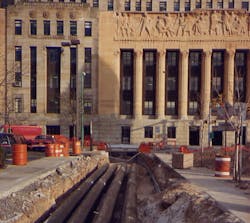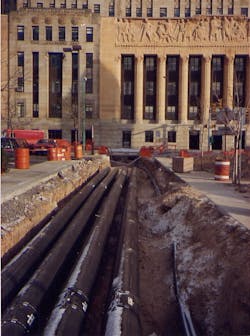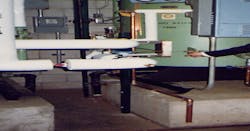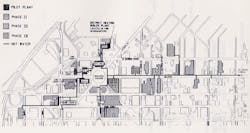Lessons from Buffalo: Evaluating Decades of District Heating
By Dr. ISHAI OLIKER, P.E., Joseph Technology Corp., Montvale NJ
The development of a district heating or cooling system in a city is a very difficult and long development process.
The best way to start is the development of a piping loop system connecting two or three buildings. Once those connected customers recognize the energy savings, it is then much easier to promote and expand the piping system to more customers (buildings). It is also very important to implement from the beginning the optimum and reliable energy generation and thermal distribution technology. This paper demonstrates just such an approach by describing the beginning of development of the district heating system still in use today in the City of Buffalo, NY.
Buffalo is one of a growing number of communities in the U.S. that have discovered the advantages of hot water district heating (DH) over the last few decades.1, 2 These advantages include lower and stabilized energy cost, improved air quality, high reliability, lower maintenance and operating costs, reduced space requirements for boiler, equipment, and consequently improved urban economic development and commercial revitalization opportunities.
The Buffalo DH project began in 1986 with a feasibility study financed by the New York State Energy Research and Development Authority (NYSERDA). That study indicated that DH would be feasible in downtown Buffalo. So Development Downtown, Inc. and NYSERDA, in cooperation with the Mayor's Office and the Dept. of Public Works, started the design of the project for district heating development and implementation in downtown Buffalo.
The project was constructed in 1987 under the direction of the district energy expert Dr. I. Oliker (the author), who was also responsible for development of the district heating system in the City of Jamestown, NY1. The circumstances were favorable for construction because the Buffalo City Hall steam boiler plant required replacement after 60 years of service, and City Hall represented a substantial heating load. Four nearby buildings were also considered as prospective customers for the DH system: the city-owned City Court and Fire Headquarters, and the privately owned Buffalo Athletic Club and Old City Court Buildings (Figure 1).
It was decided to install a gas-fired boiler plant in the Fire HQ to supply heat to the five buildings. Since it was not practical to modify the steam-heated City Hall and Fire HQ to accept hot water DH within the short time allowed for construction, a new steam boiler, adaptable for later conversion to hot water, was installed in the Fire HQ to supply City Hall. Two new hot water boilers were installed to supply the other buildings in the DH system.
A two-pipe system between Fire HQ and City Hall to serve the steam requirements of the latter was selected. The pipes were sized to accommodate hot water after future conversion of City Hall to hot water. Another two-pipe system from Fire HQ passes hot water through the basement of City Hall toward the south, where the pilot project customers were located.
The City of Buffalo and NYERDA jointly financed the pilot project with Development Downtown, Inc.
Building Heat Load Assessment
Peak heat loads for comfort heating were determined based on the heating degree days for the heating season in which fuel records were obtained and adjusted to account for site-specific parameters. The comfort heating loads are based on a 3°F outdoor design temperature. Estimated heat usage rates for domestic hot water were assumed constant throughout the year and to occur during normal hours. This internal heat use rate was determined based on fuel consumption in summer months judged to reflect non-comfort heating use throughout the year. The separate heat loads for the buildings appear in this chart:
District Boiler Plant
For the City Hall steam heating requirements, one 500 hp gas-fired steam boiler was selected. Although the actual peak load is lower, the extra capacity would be beneficial when the boiler is incorporated in the hot water DH system and represents a trade-off between a loss in efficiency in current operation and the need for future capacity. Two 800 hp gas-fired hot water boilers were selected for hot water production.
Since the peak DH load requirement for the pilot project was only about 700 hp, there is excess capacity as well as a standby 800 hp boiler. This extra capacity would be needed in the future, and the cost of adding the boiler to the pilot project was minimal compared with adding a boiler later. Standby capacity was also an important consideration for customers without backup heating system capacity.
The three new boilers were installed in close proximity to the DH customers in the Fire HQ which already has two 100 hp boilers that supply steam for heating the building. After City Hall and the Fire HQ were converted to hot water, the three steam boilers were incorporated in the hot water boiler plant. This increased the boiler plant capacity and enhanced seasonal operating efficiency because the boilers could be staged to operate at peak efficiencies and cycling of the large boilers could be eliminated.
Three 15 hp pumps rated at 300 gpm and 80 ft-TDH were selected to circulate the hot water. Two larger variable speed pumps were planned to accommodate future loads. Each 12-in. piping loop was able to circulate over 3,000 gpm.
Other items for the boiler plant included a 4,000-gallon expansion tank, a make-up water softener system, and a chemical treatment system for the steam boiler. The existing chimney was used, with the three new boiler breechings joining a common flue.
Transmission and Distribution Piping
The pilot system piping network connected the DH boiler plant in Fire HQ with City Hall, City Court, Old City Court and the Buffalo Athletic Club buildings. The piping system was designed for peak supply temperature of 250°F and return temperature of 160°F. The supply temperature varied based upon outdoor air temperature. With an outdoor temperature of 3°F or below, for example, the supply temperature is 250°F. At an outdoor temperature of 50°F and above, the supply water temperature is 160°F. The water temperature varies linearly between 250°F and 160°F when the outdoor temperature is between 3°F and 50°F.
Of the several type of piping system designs available for DH systems, an optimum, advanced, prefabricated conduit design was selected. It consisted of a thin-walled carbon steel carrier pipe, polyurethane insulation, polyethylene casing, and a leak detection system. The conduit was manufactured and shipped to the field in lengths of 40 ft and all fittings and valves were preinsulated. The customer branches were smaller conduits of similar design.
The steel piping system expansion was accommodated by a modern technique utilizing the mechanical plasticity of the pipe at stress ranges up to the elastic limits. A steel pipe was anchored at one end, and heated from the installation temperature of 60°F to about 160°F. The pipe was then anchored at the opposite end; this does not change the physical state of the pipe, and the tension in the steel was zero. When the temperature of the pipe was increased to the operating temperature of 250°F, a compressive stress was generated in the steel pipe within allowable limits.
When the temperature was reduced, a tensile stress within the allowable limits was generated. Special pipe fittings allowed the system to be installed in accordance with this procedure. The pilot system transmission and distribution piping are shown in Figure 1. Hot water lines (not shown) run through the basements of City Hall and City Court, reducing installation costs significantly since they did not require excavation or site restoration.
Conversion to Hot Water District Heating
The rationale for the building modifications can be summarized as follows:
- Plate-type heat exchangers were used to transfer heat from the DH water supply to the building distribution system for comfort heating and internal uses (Figure 2);
- The DH water supply temperature varied according to outdoor temperature from a maximum of 250°F on the design day (3°F outdoor temperature) to approximately 160°F in summer. The building heating system distribution temperature was varied to correspond;
- Building system operating temperatures were selected to optimize the size of system components while providing for the lowest possible DH water return temperatures and maximum differential temperatures;
- Existing comfort heating equipment was evaluated for performance and adaptability when being changed from steam to hot water service;
- Existing building control systems were evaluated to determine appropriateness to the hot water DH system. Controls were revised when necessary;
- The adaptability of building domestic hot water systems to hot water DH was evaluated. These systems were not modified in cases where hot water demands did not justify the change.
- Cast iron and fin-tube radiators required removal of steam traps and installation of thermostatic radiator valves and air vents. Steam supply valves were replaced with thermostatic radiator valves to ensure positive shutoff;
- Cabinet and unit heaters required removal of the steam trap and installation of a balancing valve, air vent, and automatic shutoff valve to prevent circulation through the unit when it is shut off either manually or in response to a room thermostat;
- Air handling units with steam coils required removal of steam traps and installation of an air vent and balancing valve. Steam shutoff and control valves were replaced with valves designed for hot water service. If the coil was exposed to outside air, freeze protection was provided by a small circulation pump.
Only the City Court, Old City Court, and Buffalo Athletic Club were equipped with hot water DH in the pilot hot water DH system. The Fire HQ served only as the heat source and City Hall accommodated the hot water conduits in its basement. The latter buildings were converted from their steam systems to hot water DH in an expansion of the pilot system.
City Court
The City Court was originally equipped with four electric 540 kW boilers (three operational) for building heating. Two 30 kW electric heaters provided domestic hot water. A single plant heat exchanger was then installed to provide hot water DH to the building. The building is zoned in two heating sections; one for finned-tube radiation and the other for reheat coils in the air handling system. Existing building controls are still used except for addition of DH control valves which operate with the existing pneumatic control system. For the two separate domestic hot water systems, two heat exchangers, each with a capacity of 104,000 Btu/hr, provided a desirable increase in capacity from the original systems. The existing electric hot water boilers were retired to serve as backup. The existing electric domestic hot water tank heaters were also retired in place. Appropriate DH control and isolation valves were added and a single Btu meter was installed for the building.
Old City Court
The Old City Court building was a simple conversion to hot water DH, since it had a heat pump system which circulated water for heating and/or cooling. The heat for the system was supplied by a gas-fired steam boiler which passes steam through a convertor that heats the circulating water. Domestic hot water, supplied by several individual electric heaters, was not adapted to the DH system because the conversion was not considered cost effective.
The conversion to hot water DH was accomplished by retiring in place the existing steam boiler and steam convertor (for use as a backup) and installing a plate heat exchanger. The existing computerized building controls were used to operate the DH control valves, and a Btu meter was installed.
Buffalo Athletic Club
This is a 12-story office building which also houses the Buffalo Athletic Club. The existing heating system was a two-pipe, low-pressure steam system with two gas-fired boilers (one standby). The building was heated by cast-iron steam radiators. There were also air handling systems with steam coils on the second and fifth floors and supplementary fan coil units on the upper floors.
The steam distribution system was served by several risers. One 8-in. riser supplied steam to a down-feed, two-pipe system which served the 6th through 12th floors. There was also a single condensate return for the upper floors, with condensate collected by the single pipe in a pipe chase located between the 5th and 6th floors. Domestic hot water requirements for a restaurant and the athletic club were supplied by gas-fired heaters.
For building heating, three plate type heat exchangers were installed (one for standby). Each was sized at 2,500,000 Btu/hr because of cost savings offered by manufacturing three identical units. The units were also capable of operating with the steam boilers. Separate domestic hot water heat exchangers, along with separate Btu meters, were installed for the restaurant, as well as for the Buffalo Athletic Club domestic water heating systems.
Circulating pumps, expansion tanks, and air removal equipment were provided for each of the two building heating zones, and supply temperature controls were installed. The existing steam boilers were retired for standby capability. The existing condensate collection system was modified to allow for use of the plate heat exchangers for steam-to-hot water generation as standby.
Individual radiators were modified, including removal of the steam trap internals, installation of a thermostatic radiator valve and installation of an air vent. Steam coils in the air handling equipment were replaced with coils able to accept hot water. Isolation valves were provided on the steam and condensate piping, and the upper loop condensate return line was increased in size to allow hot water circulation.
System Expansion Strategy
Over time, the objective was to develop the system in stages, spreading the capital expenditures out in incremental investments over-the development period and allowing the system to generate revenues to offset the capital investments. The first stage of a pilot project was completed at a cost of about $1.7 million. The average annual heat load was estimated to be about 39 MMBtu/yr.
The DH boiler plant was designed with sufficient capacity to allow for expansion. One expansion (already implemented) included installation of service connections and tie-ins for four nearby buildings owned by Erie County (NY), which was accomplished within three years. Another expansion is planned north from City Hall along Delaware Avenue for as much as two (2) miles to Gates Circle where many prospective customers are located. Figure 3 shows these proposed expansions. Expansion to other areas in the future would also be feasible and desirable.
Economic Analysis
The economic analysis for the pilot hot water DH system in Buffalo indicated a payback of about four years. Heat was initially sold at $8.50/MMBtu. For the system expansion, the economic analysis used the required revenue approach to determine the necessary charges for district heating.
Annual carrying charges for the DH investment were calculated based on 100% debt financing with a bond rate of 6%. Total system costs were developed and compared with the total quantity of heat to be sold to determine the minimum required charges. The total system costs include fixed expenses, operating expenses, and gross receipt taxes.
Capital costs were escalated to the year of expenditure at a rate of 3%. They included all direct and indirect costs associated with the boiler plant and the transmission and distribution piping systems. Annual carrying charges were based on the assumption that the project would be financed by municipal bonds. The income and property tax rates are 0%, and the insurance rate is 0.5%.
The operating expenses for the DH system are comprised of pumping, operating and maintenance manpower and material, and gas costs. Pumping costs were calculated using $60/MWh, and they escalated at 3%. Operating and maintenance material costs were estimated at 1.7% of the capital costs. They also escalated at 3%.
Twenty-year economic analyses were performed for selected customers to determine the annual cash flows and paybacks. Modification costs were actual or estimated. An annual loan payment was determined based on the percentage of the modification cost and the financing terms of a 6% loan for 15 years. The customer's annual energy costs with natural gas were determined based on his present annual consumption and average cost of gas escalated at 3% per year.
The customer's annual energy costs with DH were determined based on his average annual fuel consumption, seasonal boiler efficiency, potential end use energy savings, and the calculated unit cost of district heating. Potential end use energy savings from conversion to hot water (eliminating trap losses and decreasing line losses) were included. The analysis demonstrated that the paybacks for converting to hot water DH would take between four and seven years.
Conclusion
The development of a new hot water district heating system in Buffalo is an example of how gradual long-term planning can be achieved by a cooperative effort. The state and municipal authorities and the business community, along with competent equipment manufacturers and experienced engineering and construction contractors, all accomplished installation of the pilot system within a short period of time. The original pilot system gradually expanded by adding new customers.
The end users of the hot water district heating system were satisfied with the results: reduction of energy cost and no maintenance of building boiler and associated equipment. During the system's history, the central boiler plant and the piping system were not replaced and required only routine maintenance. The underground piping leak-detection system is still in operation. The long-term system operation clearly demonstrated that implemented technology of modern prefabricated piping with a leak detection system is reliable. No corrosion of underground piping and replacement was experienced.
So, the city's investment in district heating has proved to be a good decision.
References
1 Oliker, I. Case Study: District Heating Supply from a Combined Heat and Power Plant, Consulting-Specifying Engineer magazine, February 2021;
2 Oliker, I., Phillip, M., Tortorici III, R., and Jeback, E. Development and Operation of a District Energy System in Schenectady, NY. Engineering Systems magazine, February 2021.
About the Author
Licensed in 10 states and active for more than 30 years, the author is president of Joseph Technology Corp. and former president of the International District Energy Association. He has extensive experience in district heating, cooling and CHP development projects in the U.S., former Soviet Union, Korea, and China. Contact Dr. Oliker at 201-573-0529, or via e-mail: [email protected].




